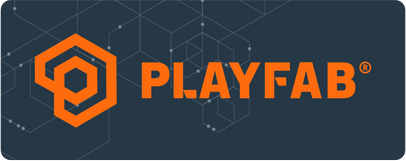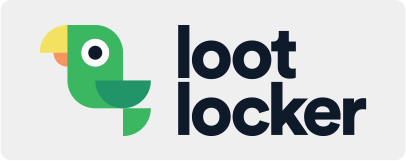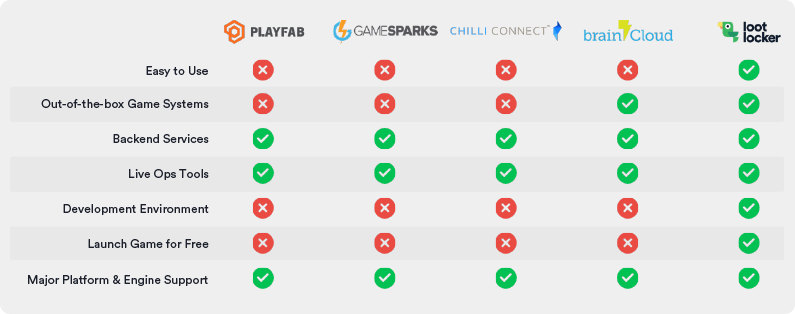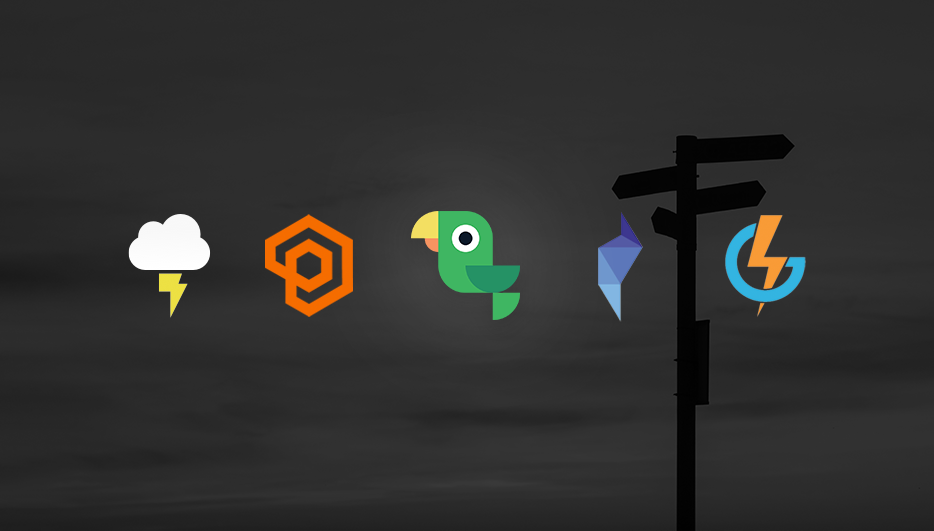Since game backend-as-a-services began appearing on the market several years ago, competition has become quite fierce. Several backend services have been purchased by larger companies, while other backends have had to shut down. There are now 5 main backends to pick from, each with their own strengths and weaknesses.
Here is a breakdown and comparison of the most popular backends that will hopefully help you decide which backend is right for you and your game.

PlayFab
Overview
PlayFab is Microsoft’s backend service built on Azure, Microsoft's proprietary server hardware. PlayFab’s focus is built around operating a live game, with lots of tools for running experiments and analytics.
Features
PlayFab is broken down into three main feature groups, Multiplayer Services, LiveOps, and Data & Analytics. PlayFab has traditional backend features like player and asset catalog management, microtransactions, and leaderboards, along with tools for boosting engagement, retention, and analytics.
Pricing
PlayFab lets you use the platform for free while your game is still in development. When you are ready to launch your game you must pay at least $99 per month or select a higher tier to access more features or larger quantities of API Calls, Reads, Writes, and storage.
![]()
ChilliConnect
Overview
ChilliConnect is a game backend dedicated to live game management, providing game services, live ops, and analytics in one place. Note: ChilliConnect was purchased by Unity in 2019 and since then the service has stopped accepting new customers at the time of writing this.
Features
ChilliConnect’s primary features are game services (eg. player accounts, multiplayer, virtual goods), a live ops toolkit (to manage game economies and run tests), and analytics.
Pricing
While ChilliConnect offered a free 30 day trial, once that runs out you need to pay at least $49 per month to access the platform. At that price point you only have access to a certain number of features and API Calls, so you might consider upgrading to a higher tier for $249 or $749 per month, depending on the scope of your game.

GameSparks
Overview
GameSparks is owned by Amazon Web Services (AWS), and has a long list of big companies using it. GameSparks presents itself as an easy way to develop, launch, and grow a game backend through its various features.
Features
GameSparks lists its main features as social and multiplayer (eg. leaderboards, matchmaking), meta-game and economies (eg. currencies, virtual goods), live game operations (eg. player management, analytics), GameSparks Core (direct access to the backend through APIs), and infrastructure and operations (eg. scaling, regions).
Pricing
GameSparks allows you to use the service while developing your game as long as you do not exceed 100 concurrent users. To launch your game you must begin paying $299 per month with a cap at 37,375 monthly active users (MAU). Above that threshold you pay an additional $0.008 per MAU.

brainCloud
Overview
brainCloud describes themselves as “the most flexible cloud-based gaming Backend-as-a-Service” with features to help you build faster and smarter, and a low-cost pricing plan. brainCloud is also one of the few independent backends (not owned by a much larger company).
Features
brainCloud has most of the same backend and live ops features as the other platforms listed so far but adds to their feature set with “Gamification” features like Achievements, Milestones, Quests, and XP.
Pricing
brainCloud lets you use their platform during your game’s development with a maximum of 100 Daily Active Users and 1,000 individual accounts. From there you can select from 3 different tiers that include different amounts of Free API Calls, starting at $15 per month, going up to $99 per month.

LootLocker
Overview
LootLocker is the indie game backend, designed to provide teams with the tools needed to develop, launch, and run the best games possible. It is built by former indie developers, comes with a lots of ready-made features out-of-the-box, and has simple, success-based pricing system.
Features
In addition to traditional backend and live ops features like asset catalog and player managers, microtransactions, leaderboards, and player segmentation, LootLocker also includes game systems like progression, missions, crafting, character classes, and collectables. LootLocker also has support for User-Generated Content and an environment control system letting you review changes made to your data before safely merging them to your production environment - both things that other platforms do not have.
Pricing
LootLocker is completely free to launch your game with, and doesn’t cost anything for the first 10,000 players every month. Once you have passed that threshold, LootLocker has a scalable pricing based on the number of additional monthly active users your game attracts. You can learn more about LootLocker's pricing here.
So there you have it: a comparison of the top 5 game backends currently available! Since that is a lot of information to process at once, we’ve made this handy chart that compares all of the backends against each other. Check it out!

